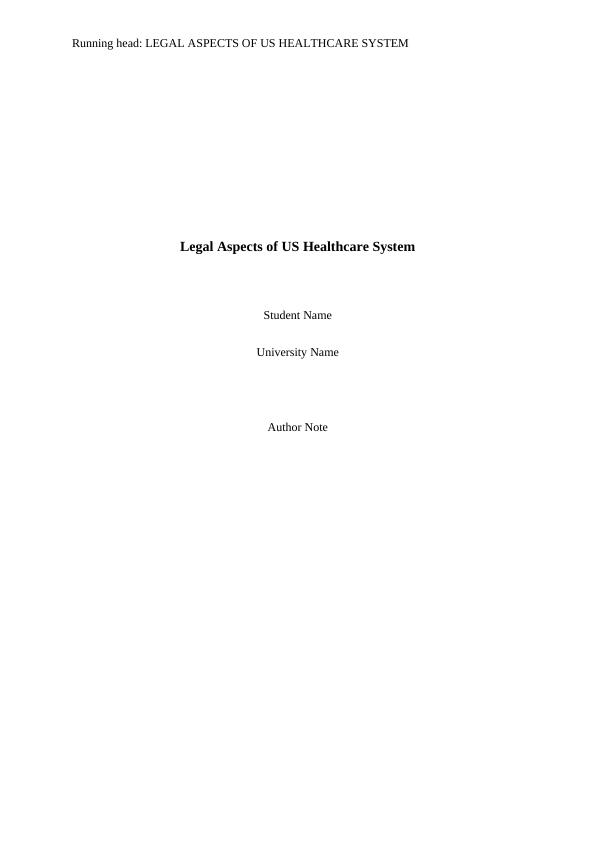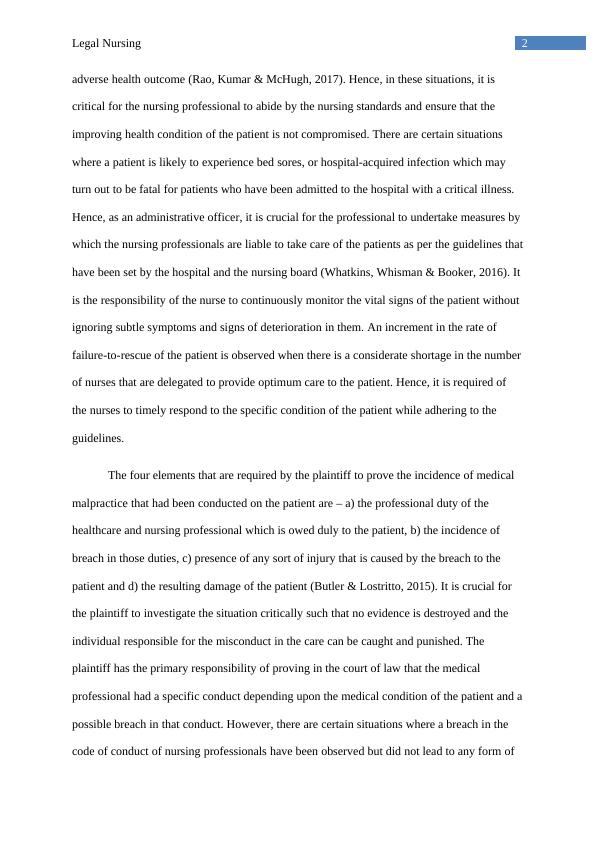Legal Aspects of Us Healthcare System
7 Pages1601 Words21 Views
Added on 2022-08-23
Legal Aspects of Us Healthcare System
Added on 2022-08-23
ShareRelated Documents
Running head: LEGAL ASPECTS OF US HEALTHCARE SYSTEM
Legal Aspects of US Healthcare System
Student Name
University Name
Author Note
Legal Aspects of US Healthcare System
Student Name
University Name
Author Note

1Legal Nursing
The prevalence of medical errors being conducted during the surgical operations and
killing around 98,000 individuals every year in the United States are under the scrutiny of the
government for quite some time (The Next Wave of Hospital Innovation to Make Patients
Safer, 2016). To counter the increasing incidence of the errors, it is crucial for the nursing
and medical professionals in the healthcare to adhere to the Surgical Care Improvement
Project (SCIP) such that a positive health outcome for the critical patient is achieved (Tsai,
Orav & Jha, 2015). The primary responsibility of the medical professionals is to adhere to the
code of conduct and perform activities under their scope of practice (Buzzacchi, Scellato &
Ughetto, 2016).
As a top administrator of the We Care Hospital, it is my responsibility to keep
checking the inclusivity of the guidelines for generating maximum patient satisfaction by the
delivery of best care for their specific medical conditions. There are several incidences where
a breach of conduct where a breach is likely like the nursing professional to miss washing
their hands before caring for the patient which may lead to fatal outcomes like an infection.
Hence, in these scenarios, it is important for the presence of strict laws such that a situation
like this does not arise any further. As an administrator, professional conduct is one of the
many clauses that a medical and nursing professional should abide by in their workplace
(Salmond & Eschevarria, 2017). Clinical Practice Guidelines have been introduced in the
healthcare systems for improving the quality of care that is to be provided to the patients and
complete adherence by the medical professionals. It is the responsibility of the head of the
administration to test the compliance rate of the professionals while they are being assessed
to take care of the patient. However, in the case of any medical professional who has
delivered care beyond their scope of practice, they are liable to punished under the law.
The phrase “failure-to-rescue” defines the incapability of the nursing professional to
avoid the increment of a life-threatening condition in a healthy patient and hence, suffers an
The prevalence of medical errors being conducted during the surgical operations and
killing around 98,000 individuals every year in the United States are under the scrutiny of the
government for quite some time (The Next Wave of Hospital Innovation to Make Patients
Safer, 2016). To counter the increasing incidence of the errors, it is crucial for the nursing
and medical professionals in the healthcare to adhere to the Surgical Care Improvement
Project (SCIP) such that a positive health outcome for the critical patient is achieved (Tsai,
Orav & Jha, 2015). The primary responsibility of the medical professionals is to adhere to the
code of conduct and perform activities under their scope of practice (Buzzacchi, Scellato &
Ughetto, 2016).
As a top administrator of the We Care Hospital, it is my responsibility to keep
checking the inclusivity of the guidelines for generating maximum patient satisfaction by the
delivery of best care for their specific medical conditions. There are several incidences where
a breach of conduct where a breach is likely like the nursing professional to miss washing
their hands before caring for the patient which may lead to fatal outcomes like an infection.
Hence, in these scenarios, it is important for the presence of strict laws such that a situation
like this does not arise any further. As an administrator, professional conduct is one of the
many clauses that a medical and nursing professional should abide by in their workplace
(Salmond & Eschevarria, 2017). Clinical Practice Guidelines have been introduced in the
healthcare systems for improving the quality of care that is to be provided to the patients and
complete adherence by the medical professionals. It is the responsibility of the head of the
administration to test the compliance rate of the professionals while they are being assessed
to take care of the patient. However, in the case of any medical professional who has
delivered care beyond their scope of practice, they are liable to punished under the law.
The phrase “failure-to-rescue” defines the incapability of the nursing professional to
avoid the increment of a life-threatening condition in a healthy patient and hence, suffers an

2Legal Nursing
adverse health outcome (Rao, Kumar & McHugh, 2017). Hence, in these situations, it is
critical for the nursing professional to abide by the nursing standards and ensure that the
improving health condition of the patient is not compromised. There are certain situations
where a patient is likely to experience bed sores, or hospital-acquired infection which may
turn out to be fatal for patients who have been admitted to the hospital with a critical illness.
Hence, as an administrative officer, it is crucial for the professional to undertake measures by
which the nursing professionals are liable to take care of the patients as per the guidelines that
have been set by the hospital and the nursing board (Whatkins, Whisman & Booker, 2016). It
is the responsibility of the nurse to continuously monitor the vital signs of the patient without
ignoring subtle symptoms and signs of deterioration in them. An increment in the rate of
failure-to-rescue of the patient is observed when there is a considerate shortage in the number
of nurses that are delegated to provide optimum care to the patient. Hence, it is required of
the nurses to timely respond to the specific condition of the patient while adhering to the
guidelines.
The four elements that are required by the plaintiff to prove the incidence of medical
malpractice that had been conducted on the patient are – a) the professional duty of the
healthcare and nursing professional which is owed duly to the patient, b) the incidence of
breach in those duties, c) presence of any sort of injury that is caused by the breach to the
patient and d) the resulting damage of the patient (Butler & Lostritto, 2015). It is crucial for
the plaintiff to investigate the situation critically such that no evidence is destroyed and the
individual responsible for the misconduct in the care can be caught and punished. The
plaintiff has the primary responsibility of proving in the court of law that the medical
professional had a specific conduct depending upon the medical condition of the patient and a
possible breach in that conduct. However, there are certain situations where a breach in the
code of conduct of nursing professionals have been observed but did not lead to any form of
adverse health outcome (Rao, Kumar & McHugh, 2017). Hence, in these situations, it is
critical for the nursing professional to abide by the nursing standards and ensure that the
improving health condition of the patient is not compromised. There are certain situations
where a patient is likely to experience bed sores, or hospital-acquired infection which may
turn out to be fatal for patients who have been admitted to the hospital with a critical illness.
Hence, as an administrative officer, it is crucial for the professional to undertake measures by
which the nursing professionals are liable to take care of the patients as per the guidelines that
have been set by the hospital and the nursing board (Whatkins, Whisman & Booker, 2016). It
is the responsibility of the nurse to continuously monitor the vital signs of the patient without
ignoring subtle symptoms and signs of deterioration in them. An increment in the rate of
failure-to-rescue of the patient is observed when there is a considerate shortage in the number
of nurses that are delegated to provide optimum care to the patient. Hence, it is required of
the nurses to timely respond to the specific condition of the patient while adhering to the
guidelines.
The four elements that are required by the plaintiff to prove the incidence of medical
malpractice that had been conducted on the patient are – a) the professional duty of the
healthcare and nursing professional which is owed duly to the patient, b) the incidence of
breach in those duties, c) presence of any sort of injury that is caused by the breach to the
patient and d) the resulting damage of the patient (Butler & Lostritto, 2015). It is crucial for
the plaintiff to investigate the situation critically such that no evidence is destroyed and the
individual responsible for the misconduct in the care can be caught and punished. The
plaintiff has the primary responsibility of proving in the court of law that the medical
professional had a specific conduct depending upon the medical condition of the patient and a
possible breach in that conduct. However, there are certain situations where a breach in the
code of conduct of nursing professionals have been observed but did not lead to any form of

End of preview
Want to access all the pages? Upload your documents or become a member.
Related Documents
Healthcare Strategies As An Administratorlg...
|6
|1180
|237
Critical Analysis of Surgical Attire Guidelines for Healthcare Professionalslg...
|10
|2717
|57
Importance of Safety and Confidentiality in Healthcarelg...
|8
|2137
|451
Impact of Nursing Care Models on Patient Safety Outcomeslg...
|4
|651
|432
Medication Error as Safety Indicator of Healthlg...
|15
|4391
|144
Nursing Conflict Resolutionlg...
|13
|3657
|50
